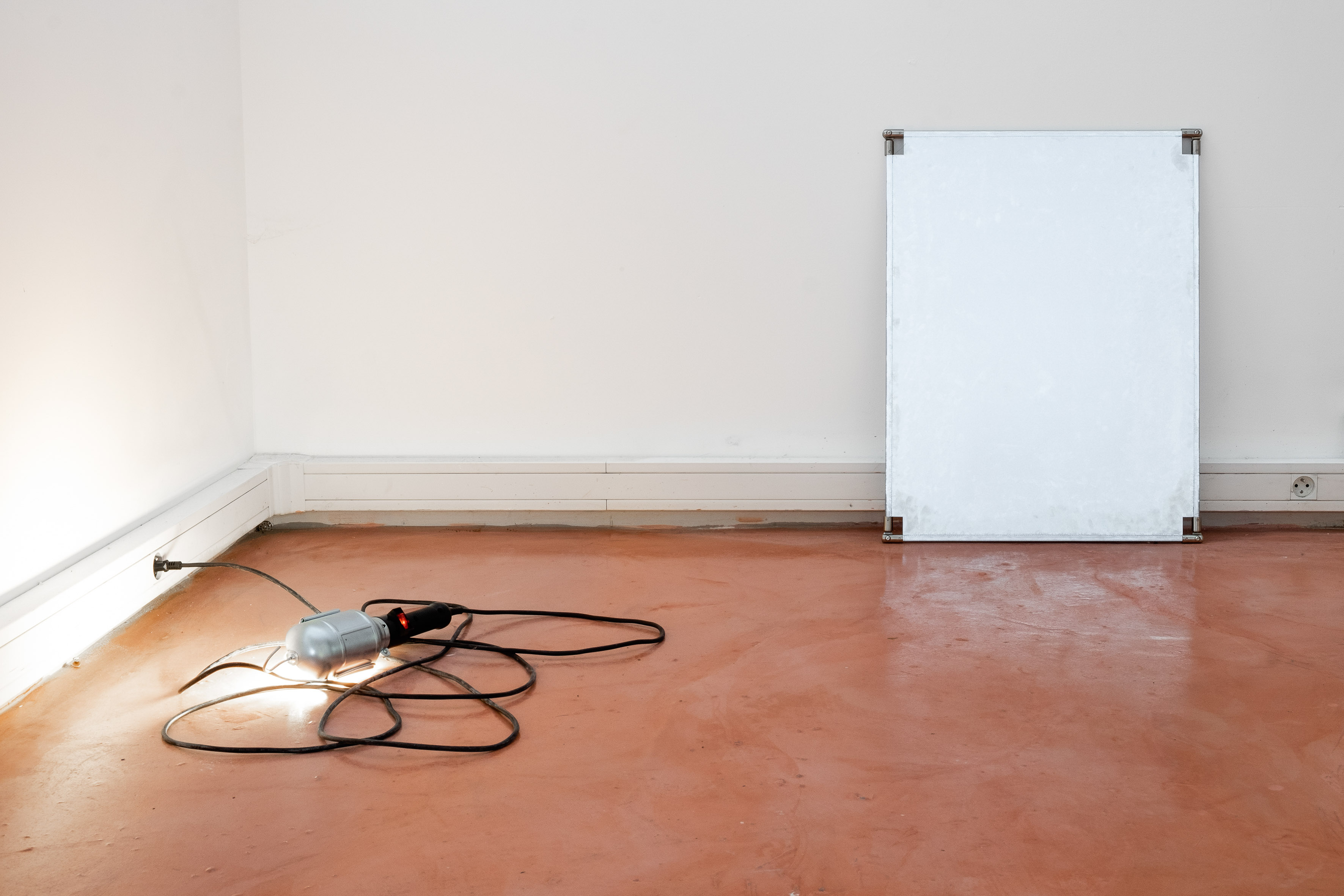#17 2018 [NON]HUMAN ASSEMBLAGES UNFOLDING OVER TIME
Scent [based on the artists thoughts and notes taken during the first visit of Le Corbusier’s
Unité d´habitation in Marseille] spread on all objects within the installation, reflective fabric, stainless steel, metal joints, c-stand, vinyl, brass, wax, diluent, oil, resin, water, text, bronzed steel 3D Print [based on the movement of the artist within the publicly accessible areas of Le Corbusiers’ Unité d´Habitation in Marseille], coated aluminum, USB-Diffuser, QR-Code [depending on the exhibition space and setting]
Sound: 02:58 min. [recorded with IBM Watson (Text-To-Speech Software)]
Dimensions of the installation are variable due to the size and conditions of the exhibition space
[NON] HUMAN ASSEMBLAGES UNFOLDING OVER TIME questions how/if a historically manifested, architectural site can be transferred to a new location – how its physically inscribed attributes, can be shifted and transferred to different [virtual] environments/ spaces.
[NON] HUMAN ASSEMBLAGES UNFOLDING OVER TIME deals with materialities, [processual] structures, hierarchies, performative and cinematic moments of movement within the Unité d’Habitation of Le Corbusier in Marseille. It is a critical comment intending to create an indelible memory of an [absent] place through an augmented olfactory level.
As the audience enters the exhibition space an omnipresent scent – like an invisible parasite – triggers their olfactory nerve. The exhibition space was infiltrated, the entire artwork/installation taken over by it. Guided by a subtle, audible score, the audience moves through a modifiable structure in which virtual and physical realities blur into an expanded idea of virtuality.
The installation [NON] HUMAN ASSEMBLAGES UNFOLDING OVER TIME] consists of several elements that can be performed by the audience in different ways. This results into a choreography of subjects and objects within a [virtual] projection surface.
[NON] HUMAN ASSEMBLAGES UNFOLDING OVER TIME] is based on the research and analysis of Le Corbusier’s Unité d’Habitation in Marseilles. A housing unit which in theory functions as a [social] structure – a mechanism that governs and shapes its inhabitants. [NON] HUMAN ASSEMBLAGES UNFOLDING OVER TIME] is part a larger-scale research project on which I have been working on together with the art historian Sonia d’Alto (IT) since 2017.








[Photos: Ricardo Almeida Roque]
VIE X MRS, Souvenir
Daniela Grabosch and Anna Thomas
curated by Sonia D’Alto
The exhibition VIE X MRS, Souvenir is a visual essay of several approaches: an exhibition, a compilation research and a collaboration on various layers, originated in the profound analysis of Le Corbusier’s Unité d´habitation.
The Unité d´habitation - an architectural structure which shows the essential movement of modern architecture represents a total break with the past and traditions, a revolution that is based on the standardization of human needs, both on an abstract level and on the level of its universal ideas from which internationalization has derived - and was, in sum, one of the revolution of modernism. A rethinking took also place in relation to the intimate space. Le Corbusier condemn any kind of memory or relationship with the past, that undermines the human action.
Here, Daniela Grabosch and Anna Thomas present a reinterpretation in progress, a decomposition and materialization of the elements of the Unité d´habitation, resulting in a reinterpretation and ambivalent reuse. For their exhibition they created a display borrowed from the accumulated suggestions derived from their research.
This is formalized in the material decomposition and in the pulverization of the components of the iconic architecture of the Cité Radieuse into small objects, serial and manual components of collaborative productions. The works exhibited in their autonomy are mostly performative sculptures: sound, reflectors, studio gear, counterweights, wearable performance props, found footage, a scent developed by Daniela Grabosch and Anna Thomas - an assemblage of (non)human actors positioned inside the exhibition space.
Souvenir objects - memories of places and spaces - are extracted from the components of the architectural structure: glass, wood, concrete and steel. Elements which now have become fabric, alloys, moving images, elements, and scores, make up a temporary display. They are props of a performance presenting themselves as language of a dynamic set: an analytical, tangible, and performative exploration of the spatial dimension of the Unité d’Habitation. The matter of form is reproduced and thus multiplies the possibilities of interpretation and criticism, creating multiple variations on displays and language, with serial objects that the public can buy or wear, and contributes to the disintegration of the rigidity of the architectural space.
The exhibited works place the audience inside a virtual structure, generating an interchange of reflection and self-reflection. An olfactory scent functions as an invisible reflector, acting like a parasite (para-site), extending all over the objects installed in space, and undermining the severe structure of the monumental module the research was based on. Slowly, this organism starts spreading everywhere, finding niches in which to hide and renders the whole set up ambivalent: it behaves like a parasite, both as an intermediate host but also an active agent of intervention in the space, fluctuating between the real and the virtual.
The entire project involved a specific audience, that of the inhabitants of the Marseilles building. They were invited to bring objects directly from their apartments that would have, in their opinion, a physical or virtual relationship with the space, and to integrate in the exhibition. Just as the ephemeral interventions that the children of the Maternelles Unit of Habitation once left their ephemeral interventions that on the concrete surfaces of the roof terrace, we find the same intention here: the opportunity to build and show a collection of artistic souvenirs- a game, creation and recreation of a space.